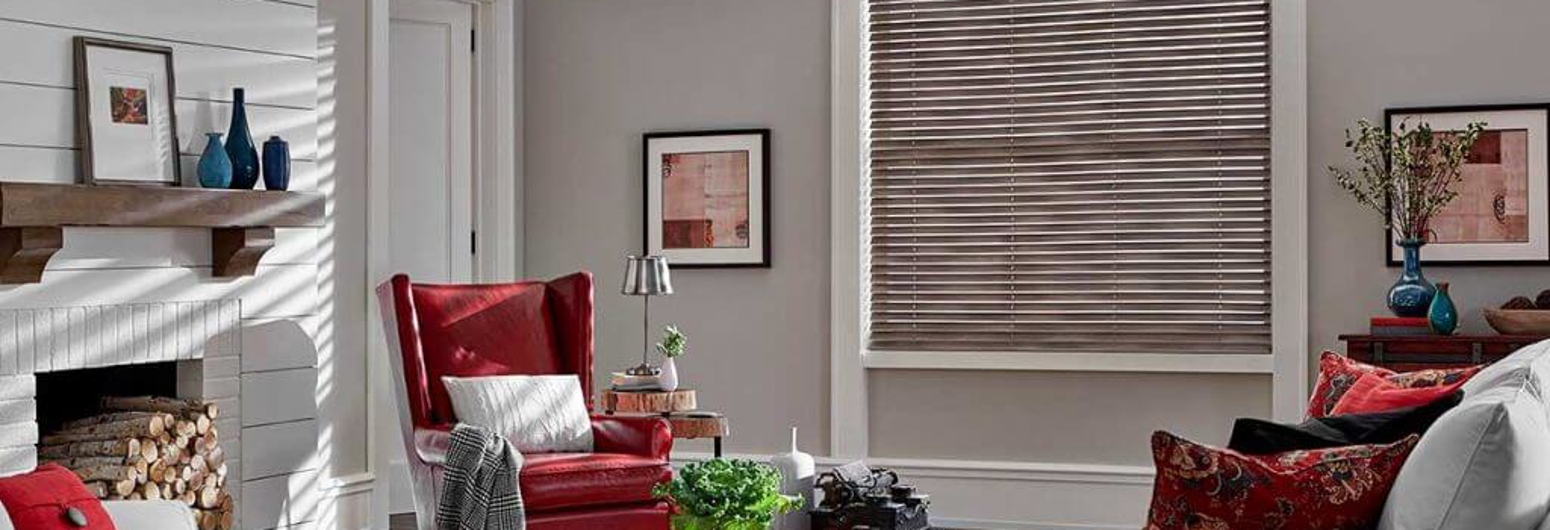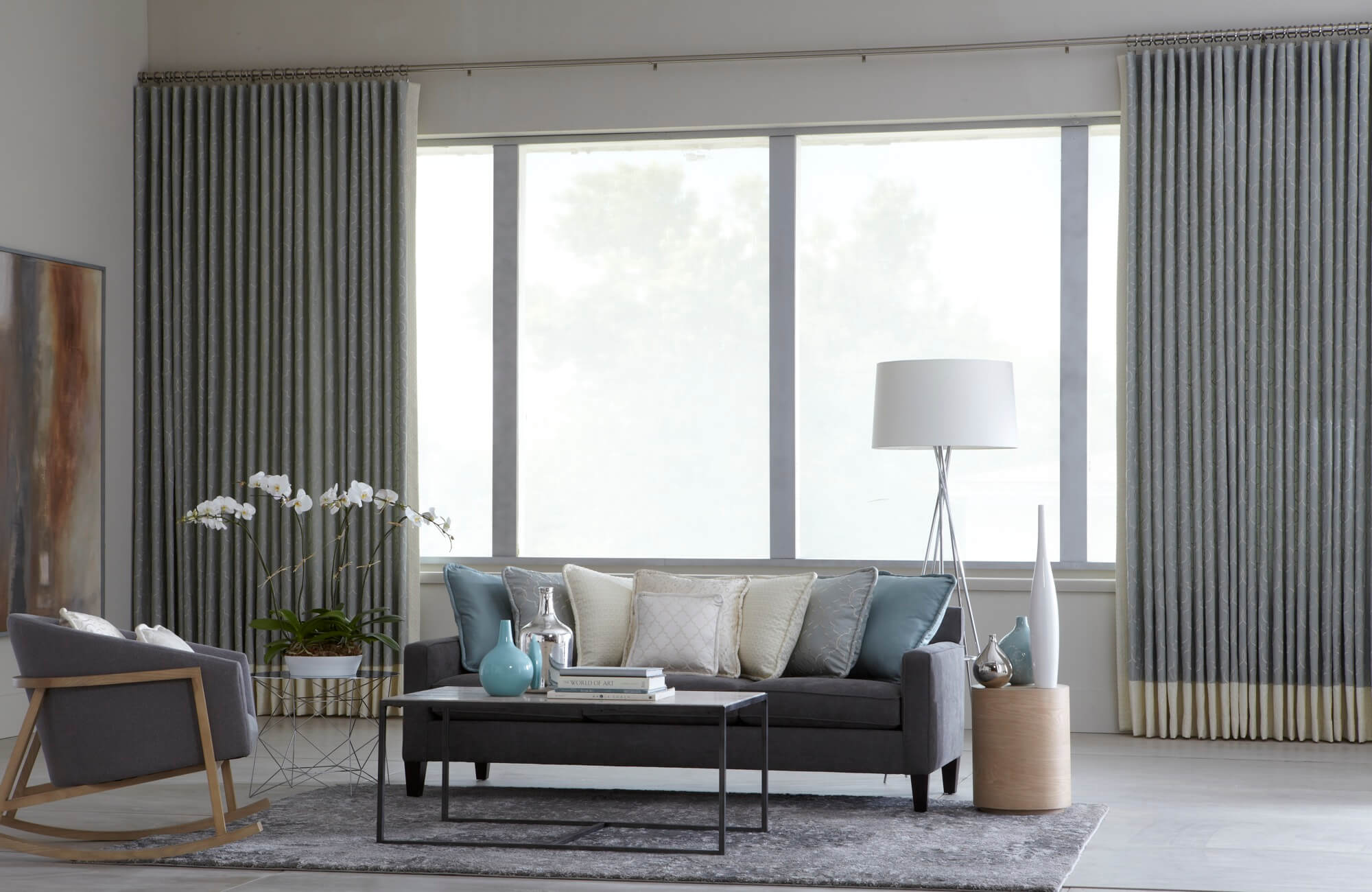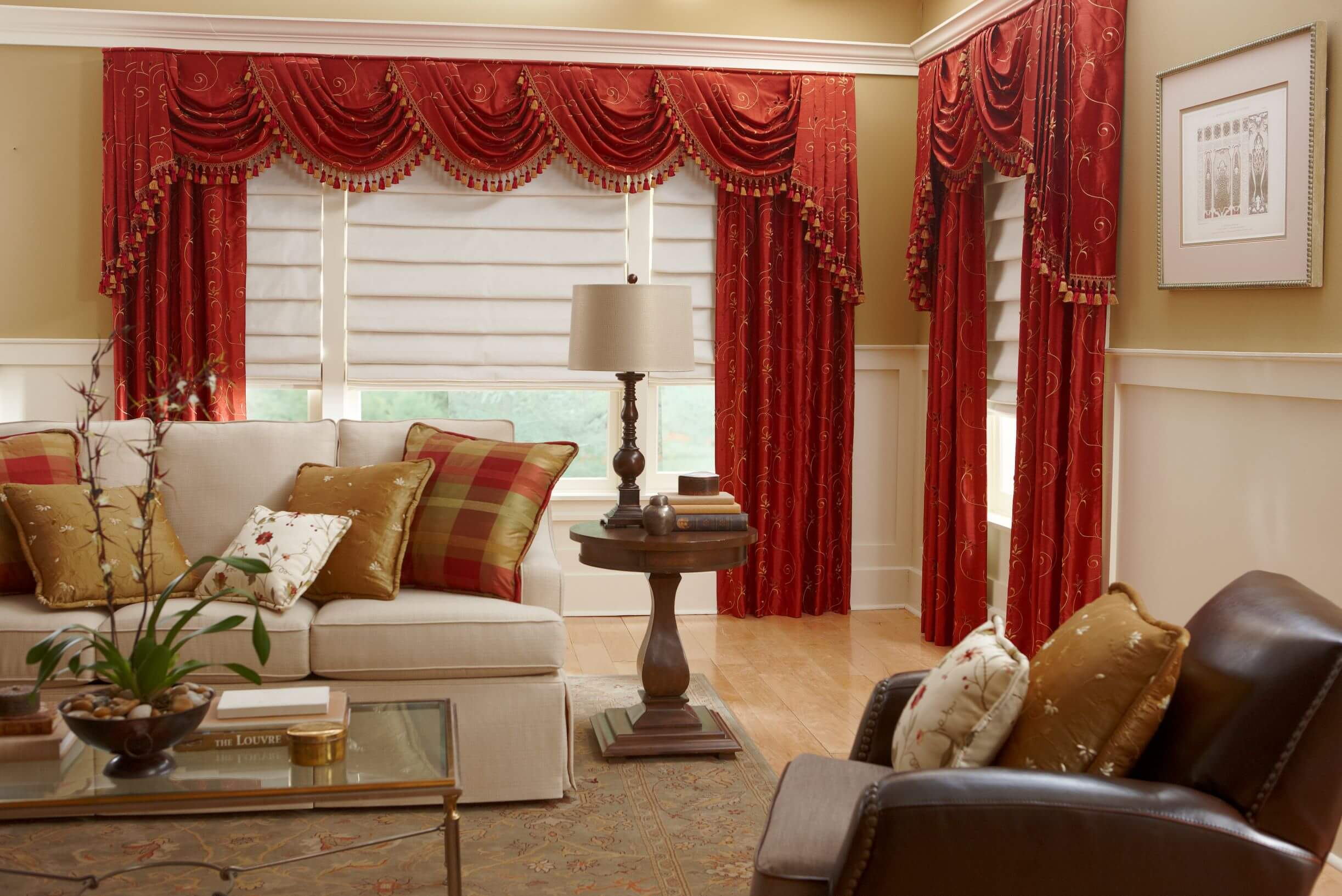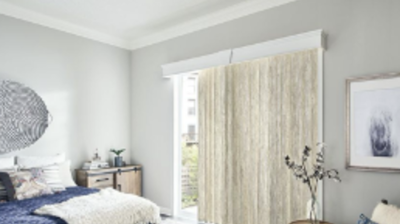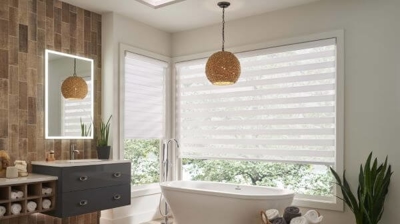As we get ready for cooler temperatures and earlier evenings, we tend to transition our wardrobes, but what about our window treatments?
Temperature changes and shorter daylight hours may require a change in what we ask our windows to provide.
In the summer, window treatments provide light control from harsh sunlight and temperature control from the heat. In the fall, sunlight becomes a bit scarcer and you may want window treatments that can easily allow more natural light to enter your rooms.
Temperatures will typically start to lower in the fall as well, so window treatments will need to be capable of keeping the heat in instead of keeping it out.
In this article, let’s discuss some of the changes that can be made to transition your window treatments and get your home ready for fall!
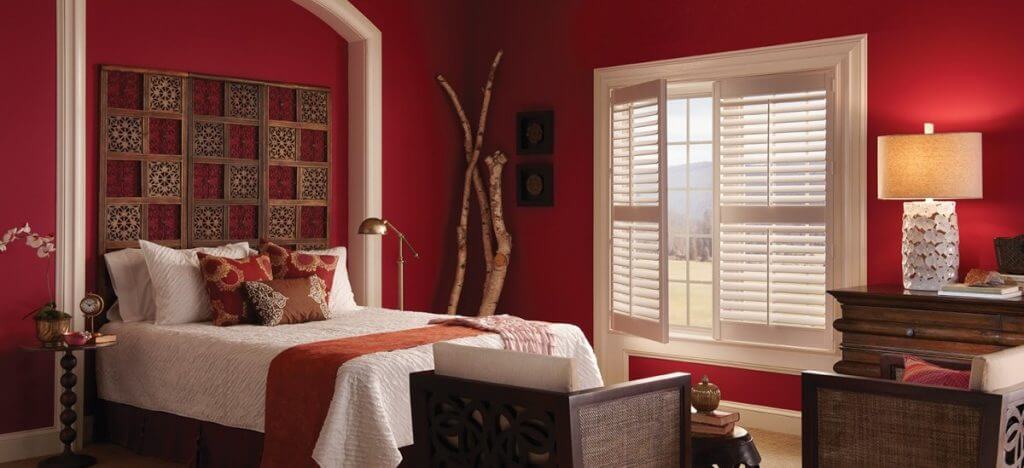
Fun, Fall Colors For Custom Window Treatments
Cooler temperatures and cozy nights are a great time to incorporate rich, fall colors into your window treatments.
While summertime may bring out bright whites and cool pastels, fall is a great time to transition towards warmer, neutral colors and rich, jewel tones. Consider swapping out the lighter, cooler colors that are optimal during the spring or summer for darker, warmer tones that will add to the cozy feeling of fall.
Deep burgundies, navy blues, and hunter greens paired with gold, copper, or bronze create dazzling combinations of fall-inspired color palettes which will provide a rich, warm, and cozy atmosphere.
Consider using color blocking for your soft window treatments. In terms of interior design, color blocking refers to the use of contrasting blocks or panels to create contrast and visual interest.
For soft window treatments, color blocking allows for multiple fabrics to be used within the same treatment to add depth and dimension. Pairing two different fabrics, such as a light, cream colored fabric with a deep, royal blue for example, creates a dramatically different finished product than either would on their own.
Two solid colors can be chosen for color blocking, or a solid fabric can be paired with a pattern. The most important thing to keep in mind is the ratio of each fabric. Thirds and fifths are the best ratios to stick to when using color blocking for window treatments.
If color blocking seems too drastic, consider using edge banding for soft window treatments. Edge banding is when a strip of contrasting fabric is added to the edge of the window treatment. Banding can be used right on the inside edge, the outside edge, at the top, or at the bottom of the window treatment.
A variation of edge banding is inset banding where the band of contrast fabric is not right on the edge but a few inches in from the hem. These are wonderful options for draperies, side panels, Roman shades, or fabric top treatments and add just a touch of contrast and flair.
Another great option to add a little something to your soft window treatments is trim. Trim can be woven or stitched directly on top of the fabric of your window treatment, or it can be an extension from the hem such as tassels, pom poms, or fringe. Trim is a great opportunity to add a little glitz or glam to any soft window treatment and can instantly take your windows to the next level.
And don’t forget about patterns! Go big and bold with floral prints or geometric patterns. Choose deep, rich, complementary colors that will really stand out. With cooler weather, most of your entertaining will be indoors, which means your window treatments will be the backdrop of your parties and gatherings. Think of what colors will help you set the mood and have fun playing with pairing solids and patterns.
No matter the window treatment, a stylish top treatment is always a great option to add some color. Valances and cornices are simple to add to existing window treatments without needing major installation and are great ways to bring colors and patterns into your existing decor.
For more information on adding colors to your home or office, visit our article 5 Secrets to Simplify Color Selection when Decorating Your Home.
Choose Thicker Materials For Window Shades And Draperies
The fall is when thick blankets and flannel sheets start to emerge, so why not consider thicker material for window shades or draperies?
Heavier fabrics and thicker materials will help insulate and keep out the cold. While sheers and lacy materials are beautiful options for warmer months, they will not do much to help raise the temperature inside. Consider swapping them out for the cooler months and using heavier curtains or draperies.
In love with your light and airy curtains? Not a problem! Consider adding a liner to any window treatments that are made of lighter materials. A liner can help with temperature control and light management while still allowing your beautifully designed window treatment to hold the spotlight.
Window shades can also help add insulation to windows. Cellular shades are some of the most energy efficient window treatments available. These shades are also known as honeycomb shades due to the honeycomb pattern made by the individual cells that make up these window shades. Each cell holds a pocket of air that adds insulation between the window and the rest of the room.
Cellular shades come in a wide variety of design styles, colors, patterns, and textures. The flexible nature of cellular shades allows them to be customized to fit non-standard windows. These extremely versatile shades are wonderful additions to any window that might need a little extra insulation against the cold.
Another wonderful feature of choosing heavier materials for your fall window treatments is the added textures. Texture is an often overlooked design element, but when it is done right, texture can add so much to the feel of a space.
During cooler months, textures play an important role in creating a cozy ambiance. Think of thick, wool blankets, knotty patterns in crocheted throws, and strong, rough surfaces of wooden logs by a fireplace. All of these textures bring you to a place or warmth and comfort.
Textures have a place within window treatments as well. Beautifully stained, wooden shutters or a woven pattern of natural shades add a third dimension to what the eye sees when traveling around the room.
Well designed window treatments can also enhance other textured pieces within a room. Woven wood shades, for example, may highlight a beautiful wicker basket. A dark, wood cornice may complement the dark wood of a central piece of furniture or the fireplace mantel. When used as a complementary piece, the textures in the material of your window treatments will show off the other design elements within the room.
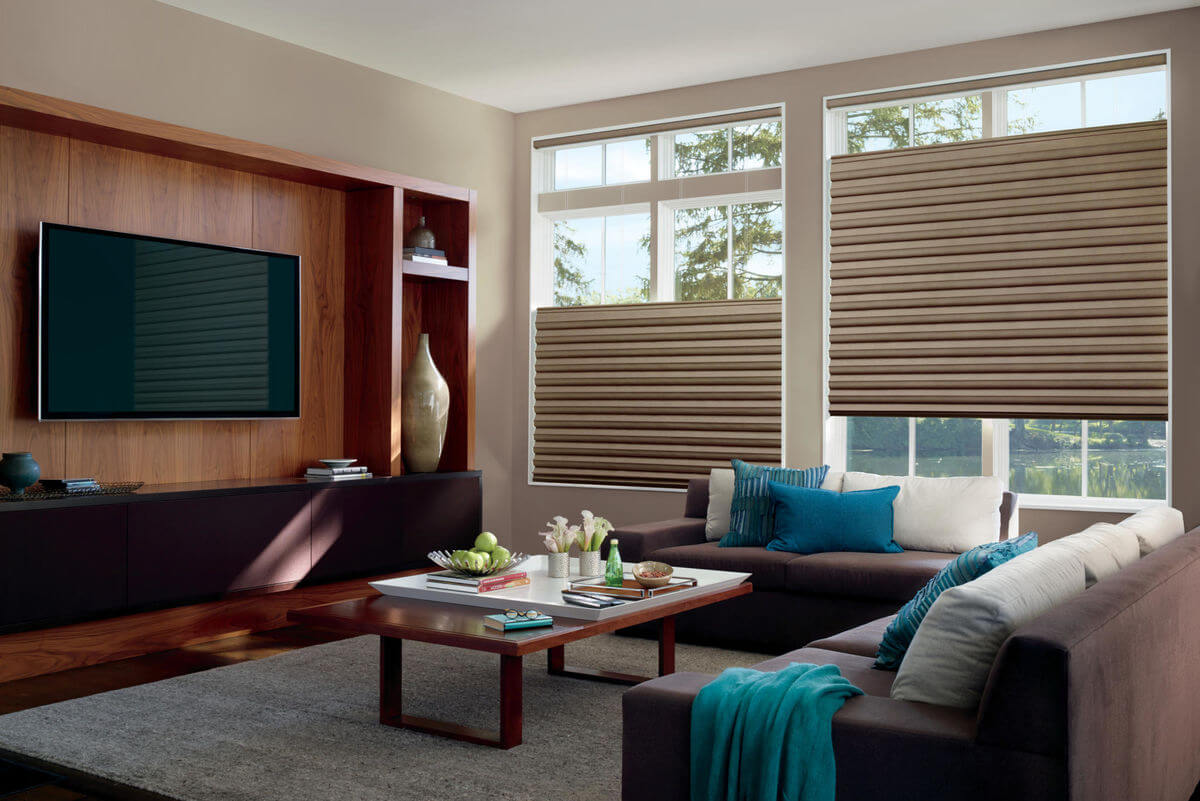
Don’t Forget About Function
It is easy to get caught up in the beautiful designs of custom window treatments simply because it is so much fun! But let’s not forget about the primary function of window treatments, especially in the fall.
South facing windows will typically receive more direct sunlight throughout the course of the day. This can be a benefit and a curse. As much as we all want natural sunlight, especially in the colder months, long hours of sun exposure may not be the best thing for our furniture, carpets, photographs, artwork, or other valuables.
Functional window treatments are fantastic additions to any window that needs a little more light control than others since these treatments are operable. Any window treatment that can be opened and closed are examples of functional window treatments.
Traversing drapes are a wonderful example of window treatments that are both stunning design elements as well as movable in order to add functionality to the room.
Window shades are also functional. Depending on the material used to design the shade, they can provide a wide range of light control options from light filtering to room darkening. Blackout shades are even an option for rooms that must be able to keep out all light, such as media rooms or home theaters.
Top down/bottom up shades are a functional option that allows the shade to be raised up from the bottom, or lowered down from the top. These versatile window shades are great additions to rooms where you may need light control, but you don’t want to block the entire window. Since these shades raise and lower independently, you can decide which portion of the window needs to be covered and which part can stay open.
When it comes to functional window treatments, operation is key! A window treatment that can not be easily opened or closed is not serving its full purpose. Adding motorization to any functional window treatment gives you complete control simply with the press of a button. And integrating motorized window treatments with a smart home system increases that control even further! Now, window treatments can be programmed to open and close with a voice command, on a preset schedule, or even remotely when you are away.
Motorization technology has made huge advancements and now it is even more convenient to add motorized window treatments into your life. Continue reading about the exciting world of motorized window treatments in our article 3 Window Treatment Challenges That Can Be Solved With smart home Systems And Motorization.
Layering Your Custom Window Treatments
By now you may be thinking how on earth do you narrow it down to just one window treatment for each window? Here’s the best part, which is why we saved this for last...You don’t have to choose just one window treatment!
Layering window treatments is a wonderful way to get all of the benefits while creating stunningly beautiful finished windows for any space.
Having more than one window treatment provides multiple options for windows. Fickle fall months can bring a wide range of weather that can change at a moment's notice. By layering different window treatments, your windows will be ready to operate as needed.
Combine stylistic wood blinds with a long, traversing drape. Add a colorful valance to your natural, woven shades. Pair light, sheer side panels with an energy efficient cellular shade to get the best of both worlds. The possibilities are endless which is what makes interior design so exciting!
There are no wrong choices in the world of design, but there is also wisdom in knowing when to stop. While layering window treatments is a wonderful way to add dimension and style, be sure that the end result is still functional.
Many times, the “less is more” approach creates a far more dramatic effect on a space. Good design is finding a balance between what is visually pleasing and what is functional for your life.
Talk with your Gotcha Covered Designer and they will be able to help you find just the right balance for any space in your home or workplace.
Conclusion
No matter the season, your window treatments should add beauty and comfort to your space.
Since there are so many wonderful window treatment options available, it can be a little overwhelming to know exactly where to get started.
Working with a Gotcha Covered Design Team Expert is the best way to take the first step. Their expertise will help get you started on the right path to finding the perfect window treatments to fit your needs, style, and budget. They can also show you some of the exciting new options for motorization and smart home systems.
Call us at (888) 650-6187 or schedule a free design consultation today! We are now offering virtual and in-home consultations.
 About the Author: Brooke Carr, Gotcha Covered
About the Author: Brooke Carr, Gotcha Covered
Brooke joined the Gotcha Covered family in 2018 as the Social Media Coordinator. She works closely with our corporate teams and our Gotcha Covered franchisees to develop insightful and helpful content for our brand.


